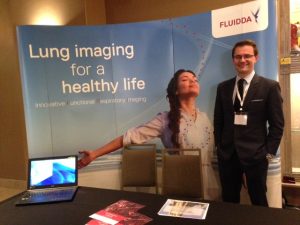The congress featured several sessions on lung modeling, including the Ted Martonen session on lung models and a separate session on advanced in vitro/ex vivo lung models, with a number of attendees citing the presentation by Dan Huh of the University of Pennsylvania on the breathing lung-on-a-chip as a highlight.

Jan de Backer of Fluidda at the ISAM congress
A significant number of presentations addressed local delivery of aerosol medication for lung diseases other than asthma and COPD, with entire sessions devoted to idiopathic pulmonary fibrosis and pulmonary infections. In the latter session, Sumathi Nambiar, Director of the FDA’s Division of Anti-Infective Products discussed “Antibacterial Drug Development: Challenges, Recent Developments,and Future Considerations to Improve Treatment of Lung Infections,” including a review of the FDA’s expedited review programs available for developers of inhaled antibiotics.
Nasal delivery presentations included several talks on unusual routes of delivery: Ronan Mac Loughlin of Aerogen discussed the use of high flow nasal therapy (HFNT) for delivery of medication to the lungs, and Laurent Vecellio of the University of Tours described a technique for delivery medication to the nose through the mouth during exhalation, which has been shown to result in significantly reduced lung and nasal valve deposition and an increase in deposition in the turbinates and rhinopharynx.
One of the presentations that generated a good deal of interest concerned expulsion of aerosols from the nose and lungs instead of delivery of aerosols to those organs. Lydia Bourouiba of MIT, whose work focuses on “the interface of fluid dynamics and disease transmission,” showed how her lab uses high speed imaging to visualize how the non-Newtonian fluids expelled during coughs and sneezes are aerosolized.


